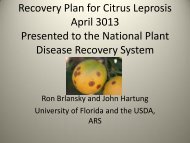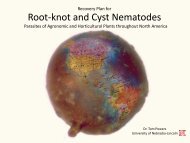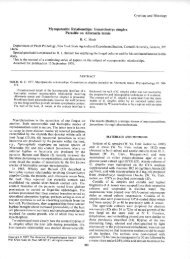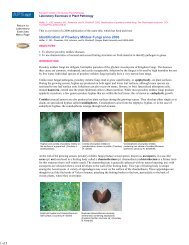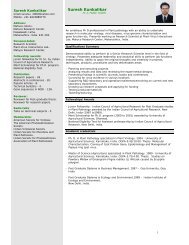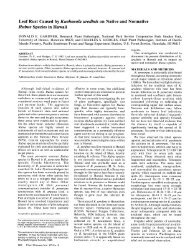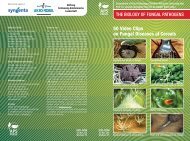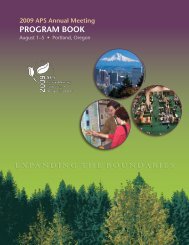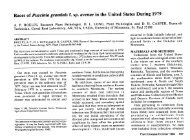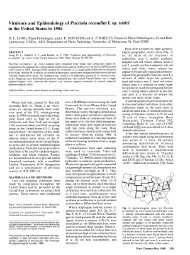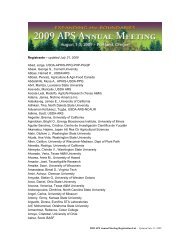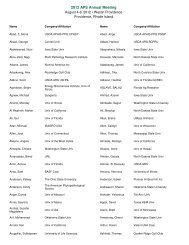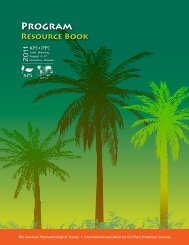view article - American Phytopathological Society
view article - American Phytopathological Society
view article - American Phytopathological Society
Create successful ePaper yourself
Turn your PDF publications into a flip-book with our unique Google optimized e-Paper software.
181<br />
THE EFFECT OF IN PLANTA PRODUCED HUMAN INTERFERON ON TYMY<br />
PRODUCTION OF TRANSGENIC TOBACCO CONTAINING COWPEA MOSAIC<br />
INFECTIONT<br />
VIRUS (CPMV) COAT PROTEIN GENES. D. L. NIDA and S. A. G.IA. de Zoeten, J. R. Penwick and T. Hohn. Friederich<br />
Ghabrial, Dept. of Plant Pathology, University of Kentucky, Giescher-Institut, P. 0. Box 2543, CH-4002, Basel,<br />
Lexington, KY 40546-0091<br />
Switzerland<br />
Preliminary data in our laboratory indicate that tobacco may<br />
serve as a model to study the potential of cross-protection<br />
against CPMV. ELISA results show that tobacco supports virus<br />
multiplication and cell-to-cell movement. Because CPMV coat<br />
proteins VP37 and VP23 are derived from a 60k polyprotein<br />
Cauliflower mosaic virus (CaMV) DNA was engineered to carry<br />
the human IFN ciD gene to the infected plant. Inoculation<br />
of turnip (Brassica rapa cv "Just Right") with CaMV strains<br />
carrying the IFN cLD gene resulted in the production of<br />
biologically active IFN oD in infected plants<br />
precursor by proteolytic processing, it was of interest to<br />
determine whether constitutive expression of the 60k<br />
polypeptide in transgenic plants would interfere with CPMV<br />
infection. Therefore, plant expression vectors were<br />
constructed by inserting cDNA representing the CPMV 60k<br />
biol (ca. 2pg/g g Fwt.) activ In nplanta In plan produced infeced IFN plants ciD did not<br />
hamper superinfection with a single stranded (+) RNA plant<br />
virus, turnip yellow mosaic virus (TYMV).<br />
precursor into the binary Ti vector pMON530. Constructs<br />
containing CPMV coat protein genes in sense and antisense 186<br />
orientations were generated. Transgenic plants are being<br />
produced via Agrobacterium cocultivation and selection on<br />
kanamycin-containing medium.<br />
GENOMIC CHARACTERIZATION OF BEET CURLY TOP VIRUS ISOLATES.<br />
Stenger and J. E. Duffus, USDA-ARS, Salinas, CA, 93905.<br />
0. C.<br />
Full-length, infectious DNA clones have been constructed for<br />
three distinct isolates of beet curly top virus (BCTV).<br />
182 Progeny virus derived from cloned genomes of the Logan (sev<br />
CELL-FREE STUDIES OF TEV 49KDA PROTEINASE PROCESSING: on Beta vulgaris, wide host range), Worland (mild on B.<br />
DIFFERENTIAL CLEAVAGE RATES AT DIFFERENT POLYPROTEIN vulgaris, wide host range), and Horseradish (narrow host range)<br />
JUNCTIONS. W, G, Dougherty and T. D. Parks, Dept. of isolates were transmitted by Circulifer tenellus, and displayed<br />
Microbiology, Oregon State Univ., Corvallis, OR 97331-3804. the same phenotypes as the original isolates. A fourth BCTV<br />
genome (severe, wide host range) was inadvertently cloned as a<br />
Tobacco etch virus (TEV) 49kDa proteinase recognizes a contaminant of the Horseradish isolate. Southern hybridization<br />
specific heptapeptide sequence at five locations on the TEV assays indicated that each cloned genome shared sequence<br />
polyprotein. This consensus cleavage sequence contains both relatedness with a full-length, infectious BCTV DNA clone<br />
conserved and nonconserved positions. In cell free studies, previously characterized by Stanley et al (EMBO J 5:1761).<br />
cleavage at the 50kDa/7lkDa protein junction proceeded at a Endonuclease restriction maps developed for the cloned BCTV<br />
slow rate relative to processing at the 58kDa/3OkDa cleavage genomes were distinct from one another. Infectivity assays<br />
site. Site directed mutagenesis of TEV cDNA sequences was determined that plasmids containing tandem repeats of BCTV<br />
performed, such that the nonconserved positions of the genomes were generally more infectious than excised linear<br />
50kDa/71kDa site were converted into those amino acids found BCTV DNA inserts.<br />
at the 58kDa/3OkDa cleavage site. Reciprocal mutations of<br />
the 58kDa/3OkDa site were also tested. In each case,<br />
processing of the 58kDa/3OkDa sequence proceeded at a faster 187<br />
rate. These data suggest that post translational regulation<br />
of gene expression in TEV may be possible via differential MUTAGENESIS OF GENE VI of CAULIMOVIRUSES RESULTS IN CHANGES IN<br />
proteolytic processing at various gene product junctions. THE DISEASE PHENOTYPE. E. P. Broglio and R. J. Shepherd.<br />
University of Kentucky, Lexington, KY 40506.<br />
A CaMV hybrid genome was constructed which contained unique<br />
183 restriction sites bordering gene VI that allowed its sequences<br />
DETECTION OF PLANT RNA VIRUS-SPECIFIC RIBONUCLEOPROTEIN to be subcloned, mutagenized and then ligated into the remain-<br />
COMPLEXES IN INFECTED CELL EXTRACTS. R French. USDA, ARS, der of the genome. Changes in the primary structure of gene VI<br />
Department of Plant Pathology, University of Nebraska, Lincoln, NE were made by linker-insertion mutagenesis. Of the several<br />
68583. mutants constructed, three were found to be infectious and were<br />
examined for disease phenotype on Brassica campestris and several<br />
solanaceous hosts. The infectious mutants and the parent<br />
Within cells, both cellular and viral RNAs probably exist as complex ribo- virus displayed a similar phenotype on B. campestris and two<br />
nucleoproteins. In order to detect RNA virus-specific ribonucleoproteins in Nicotiana species, N_. edwardsonii and N. bigelovii. In Datura<br />
a general way, antiserum to double-stranded RNA (dsRNA) was used to stramonium one of the mutants induced a-distinctly differen<br />
immunoprecipitate complexes fror barley stripe mosaic virus (BSMV, phenotype. This result supports previous reports that gene VI<br />
brome mosaic virus, or tobacco mosaic virus-infected barley protoplasts. is largely responsible for disease induction.<br />
Radiolabeled protein components of the complexes were then detected by<br />
SDS-PAGE and fluorography. Immunoprecipitates from mock-inoculated<br />
protoplasts contained little protein while those from infected cells revealed<br />
several proteins unique for each virus, including coat protein. Extracts<br />
from BSMV-infected cells contained polypeptides of ca. 140, 60, 25<br />
(coat), 20 and 18 kD. UV irradiation of cells prior to extraction increased<br />
the yield of protein suggesting that the immunoprecipitated proteins are<br />
intimately associated with RNA in yiVQ. Several types of complexes may be<br />
precipitated because synthetic dsRNA and BSIMV virion RNA were both<br />
partially effective in competition assays.<br />
184<br />
COMPARISON OF SYMPTOMS ASSOCIATED WITH EXPRESSION OF CaNV GENE<br />
VI WITH TWO PROMOTERS IN TRANSGENIC PLANTS. K-B. Goldberg,<br />
J.M. Kiernan, and R.J. Shepherd. Dept. of Plant Pathology,<br />
Univ. of Kentucky, Lexington, KY 40546.<br />
Datura innoxia and Nicotiana edwardsonii were transformed with<br />
gene VI of cauliflower mosaic virus (CaMV) strains CM1841 and<br />
04 with their homologous 19S promoters or a chimeric 35S<br />
promoter-gene VI of CM1841 using the Ti-plasmid vectors pGA472<br />
or pKYLX-7, respectively. These plants are not hosts for<br />
CH1841. Expression of P62, the gene VI protein, in 0. innoxia<br />
was associated with stunting accompanied by chlorosis or<br />
necrosis. The maximum levels of P62 in these plants with either<br />
a 19S or 35S promoter were similar, as determined by western<br />
blot analysis using antiserum to P62. The transgenic N. 1B8a<br />
edwardsonii were mildly chlorotic when expressing gene VI of MOLECULAR CHARACTERIZATION OF NON-ENVELOPED BACILLIFORM VIRUSES.<br />
CM1841 hut overall the levels of P62 were much lower than N. E. Olszewski, S. L. Medberry and B. E. L. Lockhart,<br />
observed with 0. innoxia. The accumulation of P62 in N." ...<br />
edwardsonii was at least ten times greater using gene VI in Uiest fMneoa t al N518<br />
combination with a 35S promoter compared to the 19S promoters. Gienoses of several non-enveloped bacilliform viruses have been<br />
1158 PHYTOPATHOLOGY<br />
185



